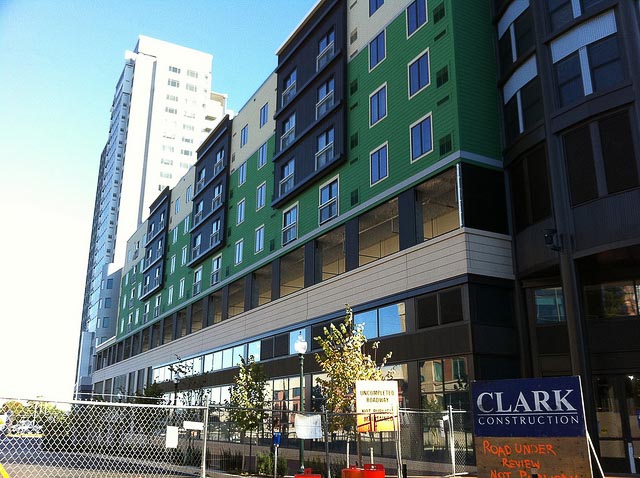There’s a simple orthodoxy behind most of today’s urban revival efforts.
Urban planners and advocates emphasize the need for homes in dense urban areas near transit, jobs, and basic amenities like grocery stores. This well-established notion of transit-oriented development is intended to wean cities off their dependency on cars and the financial and environmental costs that come with them.
But practically speaking, the “transit” in this context generally does not mean local bus routes. It means more expensive options, like subways, light-rail, or improved bus services with their own lanes.
None of this is particularly new. And there’s plenty of evidence that people who live near transit are in fact more likely to use transit and less likely to drive or own a car
But what if people who live near transit stations drive less and own fewer cars for reasons that have nothing to do with the transit stations?
People in transit-oriented developments might actually drive less because those projects are usually in dense areas with scarce parking, heavy traffic, and proximity to lots of jobs and grocery stores. Or it might be because those projects feature smaller, rental apartments that are options for younger people without kids and with lower incomes.
Maybe the transit part of transit-oriented development isn’t all that important.
The Research
That’s what Daniel Chatman suspected. The University of California – Berkeley professor of city and regional planning, in a study published in the Journal of the American Planning Association, surveyed residents within 2 miles of 10 rail stations in New Jersey to understand their driving behavior and how it relates to transit and other factors.
His findings were stark. Transit wasn’t the most important factor in decreasing driving. In fact, transit wasn’t really significant at all. He summarized the study in a recent issue of Access magazine, a publication of the University of California that tries to translate research into layman’s language to inform policy debates.
Of the people who responded to his survey, Chatman focuses on those who live especially close to a transit station (less than .4 miles from the station), and those in relatively new housing (less than 7 years old). It’s essentially a proxy for those who live in “transit-oriented development,” as opposed to the existing, older housing in the neighborhood.
The Findings
Those people relied on cars less than others in the neighborhood. They owned fewer cars, were less likely to drive to work, and took fewer car trips to buy groceries.
People in new homes near rail stations owned 27 percent fewer cars per person. But once you control for other factors, the effect disappeared entirely.
Rather, the most important factors were the scarcity of parking and the number of bus stations in the vicinity. Neighborhoods with little parking and lots of bus service cut car ownership by 44 percent.
“When all of these other factors were considered (bus access, parking availability, job and population density, and housing type), rail access had no effect on auto ownership,” Chatman wrote.
The same basic dynamic played out with driving to work and driving to get groceries, too.
“In this study, lower auto ownership and use in TODs was not from the T (transit)—or at least, not from the R (rail),” he wrote.
What really mattered was scarce parking, ample bus service, smaller apartments, more rental apartments, more stuff within walking distance, and being close to downtown jobs.
The Implications
The findings cast doubt on the wisdom of well-meaning policies that make it easier for developers to build projects near transit stations.
“A better strategy would be to provide incentives for building smaller rental units with less on- and off-street parking in locations with better bus service and higher employment density,” Chatman writes.
And if nothing else, developments near transit should be built with little parking. That’s the only way they’ll have any effect on how much people drive.
It also means neighborhoods that don’t have high-quality transit shouldn’t wait around for those expensive investments to reach them. They can achieve many of the benefits of transit-served neighborhoods without having the transit in the first place.
The findings are consistent with what’s happening in urban neighborhoods like Silver Lake and West Hollywood in Los Angeles, Hillcrest and North Park in San Diego, and Montrose and Rice Village in Houston. They’re developing into the dense, walkable vision promised by transit-oriented development, and they didn’t need transit to do it.
If further studies can replicate Chatman’s findings, it’s promising news for many cities. Their opportunities for sustainable urban development aren’t limited to the finite land right near rail stations.
They need to instead look to the other parts of the TOD playbook – less parking, more useful amenities like grocery stores, and developing in the already-developed urban core that’s near downtown.
But it also requires careful planning to make sure those projects are implemented responsibly. Angering local residents by creating congestion and parking headaches could galvanize NIMBYs to the point that cities lose their nerve for greenlighting such projects.
That means planners need to turn their attention to cutting parking minimums and rolling back regulations on building density, even in areas without rail investments, without disrupting local communities too much, Chatman argues.
“This planning puzzle deserves our focused attention,” he writes. “The pursuit of rail-oriented development may be a distraction from it.”

